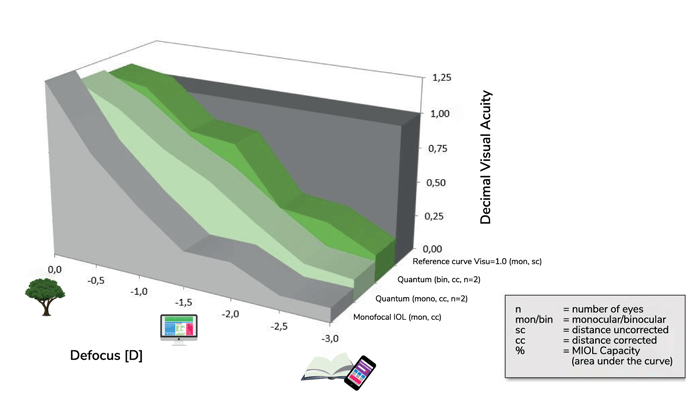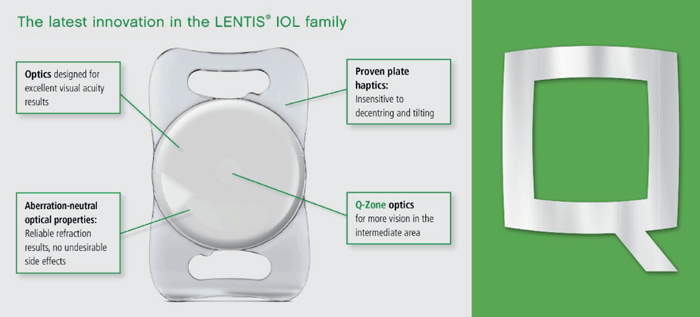
15 years ago, I started to specialize in premium eye surgery, and I have been a pioneer of toric and multifocal IOLs in Europe for many years. 10 years ago, I started to implant Teleon Surgical’s LENTIS Comfort lenses. My initial impression? The LENTIS Comfort MF15 is great for the blended vision model, thanks to its defocus curve between monofocal and MIOL; indeed, this has been my main application of the Comfort EDoF IOL for the past decade – and I developed the “Düsseldorf Formula” in the process (see box). The combination satisfied my need for a great offering for patients who wished for a good range of vision and spectacle independence – but without a significant risk of glare and halo; let’s be honest, it’s never clear how patients might tolerate those photic phenomena.
Having read Dan Reinstein’s 2011 publications on Presbyond – where he wrote about laser-blended vision using a mini-monovision strategy to modulate spherical aberration of the cornea, increasing the depth of focus by around 1.5 D – I devised a similar model for IOL implantation. My strategy offers patients spectacle independence at different lengths, with no photic phenomena or decreased contrast sensitivity. Using LENTIS Comfort IOLs implanted bilaterally, I achieve a zone of blended vision for my patients; the target in the dominant eye being emmetropia, with -1.5 D in the nondominant eye. Patients have enjoyed great distance UCVA, very good intermediate UCVA, and minimal dysphotopsia in the dominant eye, as well as great intermediate UCVA and functional near UCVA in the nondominant eye. On the basis of these game-changing results, I’ve used this model in 80 percent of patients who ask to be free of glasses.
If it ain’t broke, why add to it?
When I first heard about the LENTIS Quantum lens, I originally questioned the need for a new monofocal on the market – perhaps because I’ve been so happy with the results achieved with LENTIS Comfort EDoFs and my Düsseldorf Formula! When you can only see advantages and no downsides, it’s harder to imagine a niche for something new.
However, I have since learned that the Quantum lens is an “enhanced” monofocal, which means it has a significantly better defocus curve than monofocal IOLs (though not as strong as the Comfort lens) and with clear intermediate vision of up to 1.0 D. Now, I can see how this lens fills the gap between standard monofocal lenses and the LENTIS Comfort (see Box: All from one). Moreover, I think the Quantum is a very interesting IOL for surgeons to start with, as they present no greater risk of negative outcomes (such as photic phenomena) than monofocals, but they give patients a better vision as standard; in fact, in blended vision mode (Düsseldorf Formula) patients are often capable of reading books and newspapers print as a result. I see this lens as sitting very comfortably between monofocals and true EDoF IOLs.

All from one
The introduction of the Quantum has reinforced to me the importance of having an IOL provider with a full portfolio of lens solutions. For us high-volume surgeons, it can be a blessing to get all our options from one company with a very varied range of IOLs, such as Teleon Surgical. If I could add a further Teleon lens model to my wish list, it would be a toric version of the Quantum IOL, extending into more emmetropia – I can see it being even more forgiving.
All about the design
As soon as I started using the Quantum lens, I realized it was special. The optical design of the Q-zone seems to be very forgiving and capable of giving patients a broader spectrum of vision than monofocal IOL. The target refraction seems to be achieved more easily than with standard monofocals, with a broad acceptance. Even if it’s slightly removed from full emmetropia, the patients don’t notice it. Their intermediate vision is better, and the blended vision approach really works. Patients are very happy, and I’ve received comments such as: “Doctor, I really gained quality of life.”
I don’t have to pre-select patients and worry about higher order aberrations; I simply implant this lens in all my standard cataract patients – except those with higher asymmetry up to now.
Based on the few dozen Quantum IOLs I have implanted so far, the rate of halo and glare is close to zero and comparable with aspheric IOL! I always keep a detailed record of outcomes, so I will be able to share more data in the future, but my first impression is that there are virtually no photic phenomena with this lens.
If I could use an enhanced monofocal lens, such as the LENTIS Quantum, for all my standard cataract patients, I would do so every time; however, right now, it is dependent on insurance cover in a given healthcare system. In an ideal world, this lens should be offered to every patient who doesn’t elect to go for premium IOLs.
I can sum up my experience with the Quantum so far in one sentence: “Better for patients, easier for clinicians.”

